
As the name implies, this machine uses rollers to compact powder and thereby increase the particle size without the use of liquids hence the term “dry granulation”. It is an alternative to wet granulation and is used primarily for moisture-sensitive products.
Granulation in general aims to give the powder two characteristics: flow and compressibility. Both are crucial in the compression stage to make tablets and capsules as they may influence the weight uniformity of the individual units, their strength (the amount of active ingredient) and even the presence or absence of defects like capping (where a tablet has a horizontal crack).
The working principle of a roller compactor consists of 4 stages: feeding, compacting, granulation and sifting.
At first, the powder mixture is fed via a hopper and pressed down by an auger (a screw feeding system that ensures accurate flow) to a pair of rollers that compact the powder into what are called flakes. The distance between the rollers and the pressure they apply can be adjusted to vary the characteristics of the flake like size and hardness. The rollers are cooled down by a supply of cold water in order to avoid overheating and thus melting of the flakes.
The flakes are then passed through a crusher / granulator that break them down into smaller parts and eventually fall into a sifter that separates the larger granules (called overs) and the smaller parts (called fines) from those with the desired particle size range. The overs and the fines may be added back to the hopper so that no material is wasted.
This being an R&D roller compactor does not have a built-in crusher / granulator nor a sifter like those used for actual production.